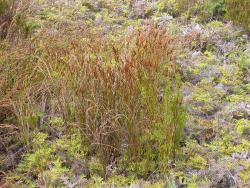- Taxon
- Gallery
- ≡ Lepyrodia traversii F.Muell. (1873)
- = Sporadanthus traversii F.Muell. (1874) nom. inval.
Slender, upright to sprawling dioecious perennial, 0.6-1 .8(-2 .5) m tall, forming dense somewhat flaccid rafts on peat an d peaty soils. Rhizome 3-10 mm diam., horizontal, sparingly branched, covered with tightly appressed, overlapping scales; scales 3-12 × 2-12 mm, broadly ovate to ± deltoid, chartaceous, dark brown, lustrous, nerves indistinct, apex rounded and mucronate. Roots 3-4 mm diam., 5-12 cm long, grey, drying to tan, soft, spongy, with few (if any) rootlets. Culms up to 2 m long, 1-5 mm diam., gradually tapering toward distal end, firm, flexuose, slender, terete, smooth, dark green-brown to brown, often blotched black; branched in upper 2/3, branches numerous, firm, flexuose, scrambling, terete; basal 50-65 mm of culm slightly swollen with soft, spongy, light brown tissue; pith absent, with 3 hollow triangular segments, these deteriorating to a ± circular cavity. Culm base with 3-7 loosely appressed, overlappin g scales; scales 8-25 × 10-12 mm, ovate to narrowly ovate, coriaceous, light brown to brown, nerves distinct, apex rounded and mucronate. Leaves along culm solitary, distant, gradually smaller toward distal end; lamina 15-30 × 6-11 mm, narrowly ovate, chartaceous, tan, brown to grey-brown, appressed to and sheathing culm, nerves distinct; margins entire to praemorse, sometimes cream; apex rounded, with mucro up to 8 mm long. Inflorescence a terminal panicle, often with cymose branching near base, 30- 150(-200) mm long, dark dull brown, upright to spreading; male and female inflorescences sparse, not crowded; flowers subtended by 2 bractlets, 2 bractlets subtended by 1 bract; inflorescenc e branchlets subtended by reduced leaves. Bracts 5.5- 10.0 × 2.6-3.0 mm, ovate, narrowly ovate to lanceolate, light brown, membranous, apex acuminate, margins fimbriate. Bractlets 5.2-5.8 × 1.0-1.6 mm, lanceolate, membranous, light brown to yellow brown, apex acuminate, margins entire. Flowers pedicellate to almost sessile. Tepals 6, in 2 whorls of 3, 4.0-6.0 × 1.0-1.2 mm, lanceolate, light brown, channelled, keeled, apex strongly acuminate. Stipe 0.3-0.4 mm long. Male flowers with 3 stamens; filaments 1.6-3.0 mm long, anthers 1.8-2.3 mm long, cream, unilocular, medifixed, pollen yellow; pistil rudimentary. Female flowers with 1 pistil; style 1.0- 1.5 mm long, pale orange, papillose on adaxial surface; ovary 0.6-0.7 × 0.3-0.4 mm, ellipsoid, brown to light brown, glossy; staminodes 3, each 1.5- 1.6 mm long. Fruit 3.0-3.5 × 1.0-1.2 mm, oblongellipsoid, light brown to brown, sutures not prominent, surmounted by persistent short style; indehiscent. Seed 1.2–1.5 × 0.9–1.0 mm, oblong to broadly ovate, dark brown; testa membranous; surface bireticulate, primary pattern prominent with rectangular to rectangular-polygonal, ridges c. 1 mm wide, secondary pattern prominent, irregular, ridges 5–7 mm wide, endosperm white.
[Reproduced from de Lange et al. (1999, New Zealand J. Bot. 37: 413–431) with permission from The Royal Society of New Zealand.]
Flowering: Oct.–Dec.; Fruiting: Feb.–Mar.




